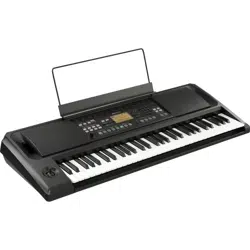Loading ...
Loading ...
Loading ...

SETTING functions
22
List of SETTING functions
(*: Factory default seing value)
Page Parameter Seings Contents of seings
P.01 KeyResponse Soft Touch
Medium Touch*
Hard Touch
Fixed_001...127
Sets the ratio of volume change when playing the keyboard at dierent velocities (the
strength at which your ngers strike the keyboard).
P.02 PtchBndRange
(Pitch Bend Range)
Style Seing*
O
01 ... 12
Sets the range of pitch change (how high or low the sound is) that can be made to the
keyboard part using the joystick.
Style Seing: The pitch bend range set for each style.
01...12: The pitch range can be set in semitones (12 semitones=±1 octave).
P.03 Pedal Function No Assign
Damper*
Expression
Quarter Tone
See page 21 “Changing the pedal function”.
P.04 Pedal Polarity -(KORG)*
+(Reverse)
See page 21 “Changing the pedal polarity”.
P.05 MasterTuning 427.5 ... 440.0* ...
452.9 Hz
Sets the overall tuning for the instrument (drums excepted).
P.06 Chord Detect Fingered1*
Fingered2
Fingered3
Fingered3/Bass
One Finger
Sets the method of chord recognition.
This seing is enabled when the split function is on. When split is o, “Fingered3” is
enabled.
Fingered1: You can play a single note or multiple notes. When you play a single note,
this is recognized as a major chord.
Fingered2: You need to play at least three notes for the chord to be recognized. Playing
only one note will play back in unison. The root and the 5th will be recognized as a
major chord when you play them.
Fingered3: You always need to play at least three notes for the chord to be recognized.
Fingered3/Bass: The Fingered3 seing is enabled, with the addition of bass inversions.
The lowest note of an inverted chord (the lowest note that you play of a chord) is always
considered to be the root of the chord. You can use this to make specify composite
chords like Am7/G, F/C and so on.
One Finger: Chord recognition works as follows.
- Single notes played are recognized as major chords.
- Play the root of the chord and then the white note to the left of it together for a seventh
chord (for example. if you play C3 and B2 together, you will get a C7 chord).
- Play the root of the chord and then the black note to the left of it together for a minor
chord (for example, if you play C3 and B
♭
2 together, you will get a C minor chord).
- Play the root of the chord and then the black and white notes to the left of it together
for a minor seventh chord (for example, if you play C3, B2 and B
♭
2 together, you will
get a Cm7 chord).
P.07 Scale Root Key C*...B Sets the note to be used as the root of the scale.
P.08 UpperScaleTyp
(Upper Scale Type)
KeyboardSet*
Equal
PureMajor
PureMinor
Arabic
Pythagorean
Werckmeister
Kirnberger
Slendro
Pelog
Stretch
User
“P.08 UpperScaleTyp” sets the scale for the upper part. Note that this cannot be set if “P.03
Pedal Function” is set to “Quarter Tone”.
“P.09 StyleScaleTyp” sets the scale used for the style accompaniment part and the lower
part.
KeyboardSet: This is the scale set for each style.
Equal (equal temperament tuning): This is a widely‑used scale in general use, where the
dierence in pitch between each semitone is uniform.
PureMajor (just temperament major scale): This is a scale in which the major chord for
the primary overtones selected harmonizes perfectly.
PureMinor (just temperament minor scale): This is a scale in which the minor chord for
the primary overtones selected harmonizes perfectly.
Arabic: This is a scale that includes quarter tones used in Arabian music.
Pythagorean: This is the scale used in ancient Greece, and is eective for playing
melodies.
Werckmeister: This is an equal temperament tuning used in later‑era baroque music.
Kirnberger: This was a scale created in the 18th century, mainly used for harpsichord
tuning.
Slendro: This is a scale used on gamelans in Indonesia, with ve notes per octave.
Pelog: This is another scale used on gamelans in Indonesia, with seven notes per octave.
When the key is set to “C”, use only white notes when playing (the black note pitches
use equal temperament tuning).
Stretch: This is a scale used for acoustic pianos.
User: This is a user‑dened scale.
P.09 StyleScaleTyp
(Style ScaleType)
Equal*
PureMajor
PureMinor
Arabic
Pythagorean
Werckmeister
Kirnberger
Slendro
Pelog
Stretch
User
Loading ...
Loading ...
Loading ...
